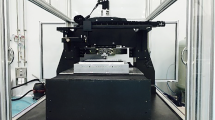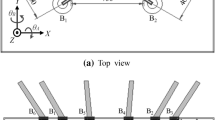Abstract
In this paper, an analytical study on the vibrations of a parallel manipulator is addressed. In the vibration equation of the moving platform, the damping and stiffness of the pods are taken into account. The eigenvalue problem of the moving platform is solved to obtain the natural frequencies. Considering the role of different factors effective on the mass and stiffness matrices of the platform, natural frequencies for different configurations are investigated. The results obtained by analytical approach are further verified through FEM simulation. The effect of variation in position and orientation of the moving platform on the change in stiffness of its supporting chain, inertia tensor and natural frequencies and mode shapes of the platform as well as the effects of different payloads are studied. The vibration of the platform in different configurations is studied in different cutting conditions. The ranges of resonance frequencies and vibration amplitudes are then investigated. Finally, proper configurations of the moving platform are determined to avoid dynamic instability in different machining conditions. It also will be illustrated in this paper that some specific features embodied in the mechanism are appropriate for high-speed milling.
Similar content being viewed by others
References
Dohner JL, Kwan CM, Regerlbrugge ME (1996) Active chatter suppression in an octahedral hexapod milling machine: a design study. In: Proceedings of SPIE—The International Society for Optical Engineering 2721:316–325
Hardage DS, Wiens GJ (1999) Modal analysis and modeling of a parallel kinematic machine. J Manuf Sci Eng 10:857–862
Hardage DS (2000) Structural dynamics of parallel kinematic machines. Ph.D. thesis, University of Florida, Gainesville
Wiens GJ, Hardage DS (2006) Structural dynamics and system identification of parallel kinematic machines. In: Proceedings of IDETC/CIE 99671
Ting Y, Chen Y-S, Jar H-C (2004) Modeling and control for a Gough–Stewart platform CNC machine. J Robotic Syst 21:609–623
Mukherjee P, Dasgupta B, Mallik AK (2007) Dynamic stability index and vibration analysis of a flexible Stewart platform. J Sound Vib 307:495–512
Hong D, Kim S, Choi WC, Song J-B (2003) Analysis of machining stability for a parallel machine tool. Mech Base Des Struct Mach 31:509–528
Mahboubkhah M, Nategh MJ, Esmaeilzadeh Khadem S (2008) Vibration analysis of machine tools’ hexapod table. Int J Adv Manuf Technol 38:1236–1243
Mahboubkhah M, Nategh MJ, Esmaeilzadeh Khadem S (2009) A comprehensive study on the free vibration of machine tools’ hexapod table. Int J Adv Manuf Technol 40:1239–1251
Pedrammehr S, Mahboubkhah M, Pakzad S (2011) An improved solution to the inverse dynamics of the general Stewart platform. IEEE International Conference on Mechatronics ICM 2011, Istanbul, April 13–15
Pedrammehr S, Mahboubkhah M, Khani N (2012) Improved dynamics equations for the generally configured Stewart platform manipulator. J Mech Sci Technol 26:711–721
Maia NM, Silva JME (1997) Theoretical and experimental modal analysis. Research Studies Press
Cheng K (2009) Machining dynamics, fundamentals, applications and practices. Springer, London
Altintas Y (2000) Manufacturing automation, metal cutting mechanics, machine tool vibrations and CNC design. Cambridge University Press, Cambridge
Yangui H, Zghal B, Kessentini A, Chevallier G, Riviere A, Haddar M, Karral C (2010) Influence of cutting and geometrical parameters on the cutting force in milling. Scientific Research, Engineering 2:751–761
Pernkopf F, Husty ML (2006) Workspace analysis of Stewart–Gough-type parallel manipulators. Proc IME C J Mech Eng Sci 220:1019–1032
Jiang Q, Gosselin CM (2008) The maximal singularity-free workspace of the Gough–Stewart platform for a given orientation. J Mech Des 130:112304 1–112304 8
Author information
Authors and Affiliations
Corresponding author
Appendices
Appendix 1
The physical specifications of the test manipulator are as follows:
-
Radius of the moving platform = 175 mm
-
Radius of the base = 400 mm
-
Angular distance between two adjacent spherical joints = 30 °;
-
Angular distance between two adjacent universal joints = 14 °
-
Minimum length of each pod = 760.2 mm
-
Maximum length of each pod =968.9 mm
-
Minimum mass of moving platform together with payload =40.6 kg
-
Maximum mass of moving platform together with payload =90.6 kg
-
Maximum course in X axis = ±130 mm, in Y axis = ±130 mm and in Z axis = 220 mm
Appendix 2
Considering P I p as the inertia tensor of the moving platform and the payload in frame {P}, the inertia tensor of the moving platform and the payload in base frame, I p , can be obtained using the parallel axes theorem [11], which yields:
where R is the rotation 3 × 3 matrix, representing the rotation of frame {P} related to frame {W}, and can be obtained as:
in which
The vector \( {{\bf r}} = {\left[ {\matrix{ {{r_x}} &{{r_y}} &{{r_z}} \\ }<!end array> } \right]^{\text{T}}} \) is the position vector of the mass centre of the moving platform and the payload in frame {W} and can be obtained as:
in which r o is the position vector of the mass centre of the moving platform and the payload in frame {P}.
The total damping and stiffness coefficient of the upper joints of the platform, C Ti and K Ti , can be obtained with series combination of damper’s and spring’s rules [8], respectively, which yields:
where C si , C ui , C ai , C di , C uni and C b are the damping coefficients of the spherical joints, the upper part of pods, the sliding joints, the lower part of pods, the universal joints and the stationary platform, respectively. K si , K ui , K ai , K di , K uni and K b are the stiffness coefficients. In the above relations, it is implicitly assumed that the stationary platform can be modelled as six concentrated vibratory elements, each situated under one pod and combined in parallel.
Each part of the pod can be considered as the homogeneous beam with uniform cross-section; therefore, the stiffness coefficients can be determined using:
where E is the modulus of elasticity; A and l are the area of the cross-section and the length of the beam, respectively.
Considering n i as the unit vector along the direction of the ith pod and q i as the position vector of the ith platform connection point on the moving platform in the base frame, the inverse Jacobian matrix can be obtained [10], which yields:
Rights and permissions
About this article
Cite this article
Pedrammehr, S., Mahboubkhah, M. & Khani, N. A study on vibration of Stewart platform-based machine tool table. Int J Adv Manuf Technol 65, 991–1007 (2013). https://doi.org/10.1007/s00170-012-4234-9
Received:
Accepted:
Published:
Issue Date:
DOI: https://doi.org/10.1007/s00170-012-4234-9




